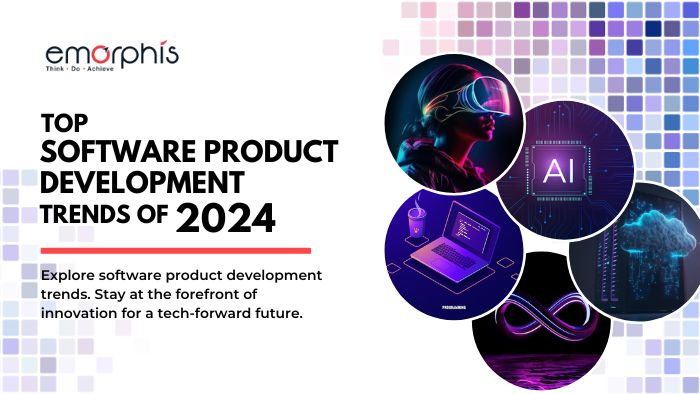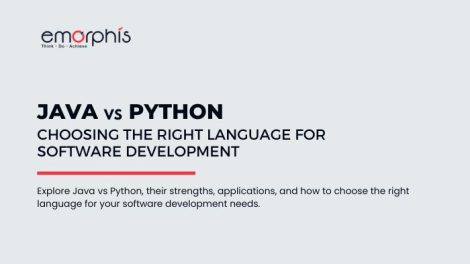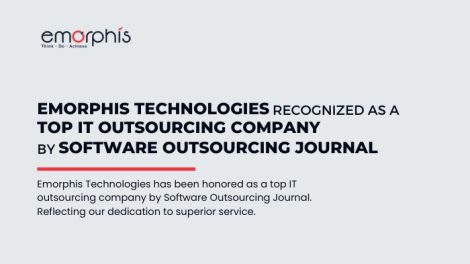At Emorphis Technologies, we believe in staying at the forefront of technological advancements, and 2024 promises to be an exciting year for software product development.
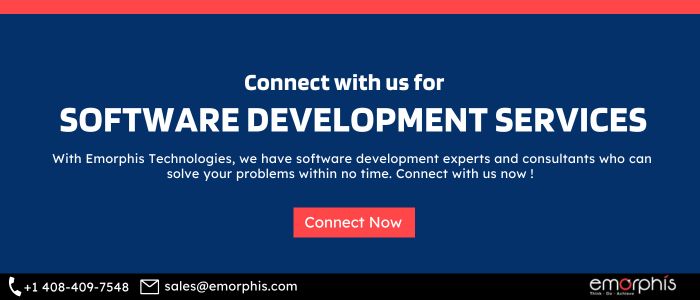
Our team of experts has diligently curated a list of the top software product development trends that will shape the industry based on the latest statistics and emerging patterns.
1. Embracing Artificial Intelligence and Machine Learning
In fact, statistics from Gartner predict that by 2025, 75% of enterprise-generated data will be processed outside traditional data centers, primarily driven by AI and ML applications. Integrating these technologies into software development not only enhances efficiency but also opens up new possibilities for innovation.
In the realm of software product development trends, the integration of Artificial Intelligence and Machine Learning stands out as a transformative force. Developers are increasingly leveraging AI/ML to not only streamline processes but also enhance user experiences. As these technologies become more accessible, they are going to define the future of software products.
Moreover, AI algorithms are powering testing automation and quality assurance, becoming indispensable in ensuring robust software performance. This not only reduces the testing cycle but also enhances the overall user experience.
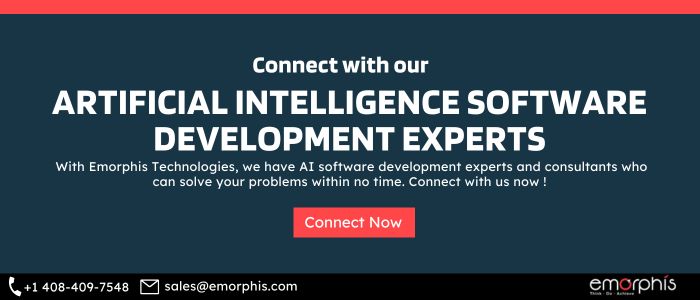
2. Progressive Web Applications (PWAs)
Moreover, the statistics reveal that PWAs are set to become the standard for web applications, with a 36% increase in PWA adoption by 2024 (source: Statista). Their offline functionality and improved performance make them a game-changer in delivering seamless user experiences across various devices and platforms.
Amidst the myriad software product development trends, the prominence of Progressive Web Apps (PWAs) cannot be overstated. Statistics show a remarkable surge in PWA adoption, signaling a paradigm shift in how we approach web applications. With offline capabilities and improved performance, PWAs are at the forefront of delivering seamless and engaging user experiences across diverse platforms.
Furthermore, cross-platform compatibility is a key advantage of PWAs, allowing businesses to reach a wider audience without compromising on performance or user satisfaction.
3. Quantum Computing Impact
As a matter of fact, quantum computing is no longer a concept from the realm of science fiction. IBM Quantum Experience reports a significant increase in users experimenting with quantum computing, highlighting its growing influence on software development.
Delving into the landscape of software product development trends, Quantum Computing emerges as a revolutionary force. The statistics speak volumes, with an increasing number of users exploring the potential of quantum computing. As we navigate 2024, quantum computing’s impact on optimizing algorithms and solving complex problems poses itself to be a game-changer in the industry.
Furthermore, the potential applications of quantum computing in optimizing algorithms and solving complex problems are vast, making it an exciting space to watch in 2024.
4. DevOps 2.0
Moreover, the evolution of DevOps practices is a testament to the industry’s commitment to continuous improvement. The integration of security into DevOps is a crucial development, as reported by a recent survey by Puppet, which found that 60% of organizations have implemented DevSecOps practices.
In the dynamic world of software product development trends, the evolution of DevOps consulting services and practices to DevOps 2.0 is a notable progression.
Furthermore, continuous integration and continuous delivery (CI/CD) enhancements streamline the software development pipeline, ensuring faster and more reliable releases.

5. Low-Code and No-Code Development Platforms
In fact, the rise of citizen developers is reshaping the software development landscape. A Forrester report predicts that by 2024, 75% of application development will be done using low-code platforms.
Among the diverse software product development trends, the rise of Low-Code and No-Code Development platforms is reshaping how to develop applications and solutions. This trend empowers not only seasoned developers but also citizen developers, fostering a collaborative approach to software creation.
Furthermore, the benefits of low-code/no-code platforms, including faster development cycles and customization options, are making them increasingly popular choices for businesses seeking agility in their software development processes.
6. Blockchain in Software Development
Moreover, the decentralization wave is sweeping through software development, and blockchain is at its forefront. According to a report from IDC, global spending on blockchain solutions is projected to reach $15.9 billion by 2024.
Within the spectrum of software product development trends, Blockchain’s impact is noteworthy. Decentralized applications (DApps) and the use of smart contracts are gaining traction. Further, ushering in a new era of heightened security measures. Looking ahead, the adoption of blockchain technology is going to fortify the foundation of software products. Also ensuring transparency and immutability.
Furthermore, the applications of smart contracts are gaining traction. With industries leveraging blockchain technology for enhanced security measures and transparent, tamper-proof transactions.
7. Edge Computing
As a matter of fact, reducing latency in software applications is more critical than ever. And for the same, edge computing is the solution. With the increasing adoption of IoT devices, Statista predicts that the number of connected devices will surpass 30 billion by 2024.
As we explore software product development trends, the significance of Edge Computing becomes evident. Reducing latency and enabling real-time data processing are paramount in this era of connectivity. The integration of Edge Computing ensures that software applications deliver optimal performance, particularly crucial in scenarios where responsiveness is non-negotiable.
Furthermore, the real-time data processing capabilities of edge computing ensure that applications deliver optimal performance, even in resource-constrained environments.
8. Augmented Reality (AR) and Virtual Reality (VR)
The integration of AR and VR in software products is creating transformative user experiences. A recent survey by Deloitte highlights that 88% of mid-sized companies are either exploring, piloting, or deploying AR and VR technologies.
Amidst the immersive software product development trends, AR and VR take center stage. Integrating these technologies into software products transcends traditional user interfaces, offering unparalleled immersive experiences. As AR and VR applications extend beyond entertainment, they redefine how we approach training, simulation, and overall user engagement.
Moreover, organizations are increasingly employing these immersive technologies for training, simulation, and creating engaging user interfaces.
Further read more details on Augmented Reality (AR) and Virtual Reality (VR) Development
9. Cybersecurity
In the landscape of software product development trends, the prioritization of cybersecurity is non-negotiable. The escalating threats underscore the need for proactive security measures. As organizations channel resources toward cybersecurity. Software development practices are evolving to ensure not just functionality but also robust protection against potential vulnerabilities.
In fact, the increasing frequency of cyber threats underscores the need for prioritizing cybersecurity in software development. According to a report by Cybersecurity Ventures. The global spending on cybersecurity products and services is expected to exceed $1 trillion from 2017 to 2024.
Moreover, proactive security measures are integrated into the development process, coupled with compliance and data privacy considerations. Furthermore, these are crucial for safeguarding software products and user data.
10. Microservices Architecture
Among the prevailing software product development trends, Microservices Architecture is a strategic approach gaining momentum. The benefits of scalability and flexibility are driving a paradigm shift in how applications develop applications and solutions. As organizations recognize the efficiency of microservices, the trend becomes integral to achieving agility and adaptability in software development processes.
Furthermore, the benefits of microservices architecture are becoming clearer, with an increasing number of organizations adopting this approach. A recent survey by O’Reilly indicates that 77% of respondents are either using or exploring microservices.
Moreover, containerization and orchestration tools contribute to the scalability and flexibility of microservices. Also allowing developers to build and deploy applications with ease.

Conclusion
To sum up, software product development trends are evolving at a rapid pace, and staying abreast of these trends is essential for developers and businesses alike. At Emorphis Technologies, our experts are dedicated to navigating the dynamic tech industry. As we step into 2024, these trends will not only shape the future of software development but also pave the way for innovative and competitive solutions. Stay tuned for more updates from the forefront of technology.



